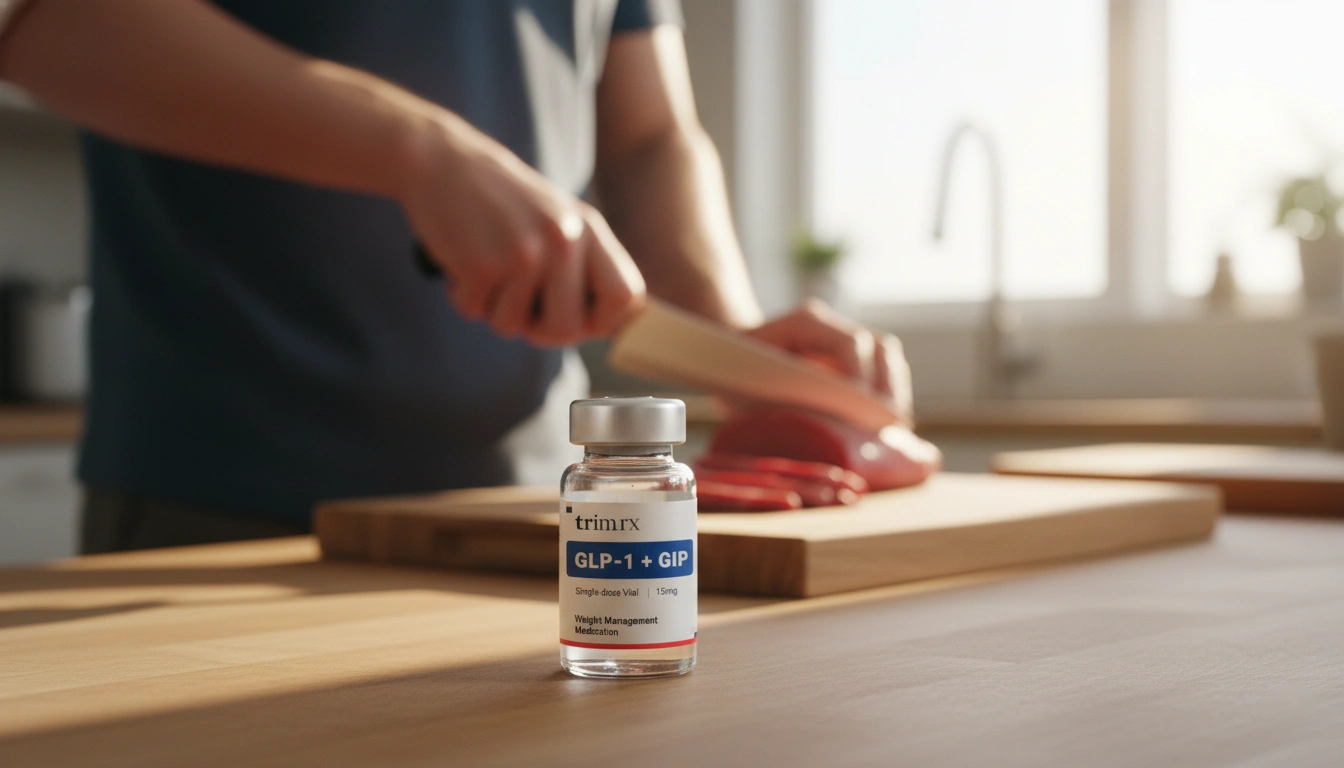Effective Strategies for Managing Nausea from GLP-1 Medications

Introduction
Nausea is an uncomfortable sensation that can disrupt daily life, and it’s a common side effect experienced by many individuals using GLP-1 receptor agonists (GLP-1 RAs) for weight management or diabetes control. Did you know that studies indicate up to 70% of patients report gastrointestinal side effects, with nausea being the most frequently cited? These medications, such as Ozempic® and Wegovy®, have revolutionized the treatment landscape for obesity and type 2 diabetes, yet the journey can be rocky due to these side effects.
Understanding how to manage nausea effectively is crucial for maintaining adherence to your treatment plan. In this blog post, we aim to equip you with practical strategies to alleviate nausea associated with GLP-1 medications, exploring dietary adjustments, lifestyle changes, and when to seek professional help. Together, we’ll navigate the complexities of these medications, ensuring that they can work for you without the hindrance of unpleasant side effects.
By the end of this post, you will have a comprehensive understanding of what helps nausea from GLP-1 medications, allowing you to take proactive steps to enhance your treatment experience. We will delve into the physiological basis of nausea, outline effective management strategies, and highlight the importance of individualized care—a principle central to our mission at TrimRx.
Understanding Nausea and GLP-1 Medications
Nausea is often linked to the way GLP-1 medications work in the body. These drugs mimic the natural hormone glucagon-like peptide-1 (GLP-1), which helps regulate blood sugar levels and appetite. While they are effective at promoting weight loss and improving glycemic control, GLP-1 medications can slow gastric emptying, leading to feelings of fullness and, often, nausea.
Why Does Nausea Occur?
The onset of nausea can be attributed to several factors, including:
- Gastric Emptying: GLP-1 medications slow down the process of gastric emptying. This means that food stays in the stomach longer, which can cause discomfort and nausea.
- Dosage Adjustments: Many patients experience increased nausea when doses are escalated during the treatment initiation phase. This is a common experience as the body adjusts to the medication.
- Dietary Choices: Certain foods can exacerbate nausea. High-fat and spicy foods are particularly notorious for causing stomach upset when combined with GLP-1 medications.
At TrimRx, we recognize that every individual’s experience with GLP-1 medications can vary significantly. Our personalized weight loss programs are designed to provide tailored solutions that consider these nuances, ensuring that you receive the care that best fits your unique health journey.
Effective Strategies to Manage Nausea
Now that we understand the underlying mechanisms of nausea, let’s explore actionable strategies to alleviate this common side effect.
1. Dietary Adjustments
What you eat can significantly influence your experience of nausea. Here are some dietary strategies to consider:
-
Eat Smaller, More Frequent Meals: Instead of three large meals a day, aim for five to six smaller meals. This approach can prevent overwhelming your digestive system and help maintain stable blood sugar levels.
-
Choose Bland Foods: Opt for bland, easily digestible foods like rice, bananas, applesauce, and toast. These foods are less likely to trigger nausea compared to rich or spicy options.
-
Stay Hydrated: Adequate hydration is vital. Sip on clear fluids, such as water, herbal tea, or broth, throughout the day. However, try to separate drink and meal times to avoid overfilling your stomach.
-
Avoid Trigger Foods: High-fat foods, spicy dishes, and overly sweet items can worsen nausea. Consider keeping a food diary to identify and eliminate any specific triggers that exacerbate your symptoms.
-
Incorporate Ginger or Peppermint: Both ginger and peppermint are well-known for their anti-nausea properties. Drinking ginger tea or peppermint tea may provide relief when nausea strikes.
2. Lifestyle Changes
In addition to dietary adjustments, specific lifestyle strategies can also help mitigate nausea:
-
Slow Down During Meals: Eating slowly not only allows you to recognize your body’s fullness signals but also aids digestion. Chew your food thoroughly to ease the digestive workload on your stomach.
-
Avoid Lying Down Right After Eating: Wait at least two to three hours after eating before lying down. This practice can help reduce pressure on your stomach and minimize the chance of nausea.
-
Monitor Stress Levels: Stress can exacerbate nausea. Consider incorporating stress-reduction techniques such as deep breathing, meditation, or light physical activity into your routine.
-
Keep a Nausea Journal: Documenting your food intake, symptoms, and any activities that seem to trigger nausea can help you and your healthcare provider identify patterns and make necessary adjustments to your treatment plan.
3. Medication Options
If nausea persists despite these management strategies, it may be beneficial to discuss pharmacological options with your healthcare provider. Some commonly prescribed medications for nausea include:
-
Ondansetron (Zofran): This anti-nausea medication can be effective for controlling severe nausea. However, it’s important to use it under the guidance of a healthcare professional, as prolonged use may lead to side effects.
-
Prokinetic Agents: Medications that help speed up gastric emptying may also be considered, depending on individual circumstances.
4. Monitoring and Follow-Up
Regular follow-ups with your healthcare provider are essential, especially in the initial stages of treatment. Your provider can adjust your medication dosage or suggest alternative treatments if nausea becomes unmanageable. It’s important to communicate openly about your experiences, as this feedback is invaluable in tailoring your treatment.
At TrimRx, we prioritize your experience and provide ongoing support. Our free assessment quiz helps us create a personalized treatment plan that addresses your specific needs, including managing side effects like nausea effectively.
Conclusion
Nausea can be one of the more challenging side effects of GLP-1 medications, but with the right strategies in place, it is manageable. By making dietary adjustments, implementing lifestyle changes, considering medication options, and maintaining open communication with your healthcare provider, you can navigate this journey more comfortably.
At TrimRx, our commitment to personalized care means we are here to support you every step of the way. If you haven’t already, we encourage you to take our free assessment quiz to see if you qualify for our personalized weight loss solutions. Together, we can work towards achieving your health goals while minimizing discomfort.
FAQ
How long does nausea last when starting GLP-1 medications?
Nausea typically occurs during the initial phase of treatment or when dosages are increased. Most instances of nausea are mild to moderate and tend to resolve within a few days to weeks as your body adjusts.
Are there specific foods I should avoid while taking GLP-1 medications?
Yes, it is advisable to avoid high-fat, spicy, and overly sweet foods, as these can exacerbate nausea. Keeping a food diary may help identify personal triggers.
Can drinking water help with nausea?
Staying hydrated is important; however, if you’re experiencing nausea, it may be best to sip fluids rather than drink large quantities at once. Try to drink fluids separate from meals.
Should I consult my doctor about nausea?
Yes, if you experience persistent or severe nausea, it is essential to consult your healthcare provider. They can provide guidance and may recommend medication adjustments or additional treatments.
How can TrimRx support me in managing side effects?
At TrimRx, we offer personalized weight loss solutions and ongoing support. Our free assessment quiz can help tailor a plan that addresses your unique needs, including the management of side effects like nausea.
By implementing these strategies and working closely with our team, you can enhance your treatment experience and focus on achieving your weight loss and health goals. Let’s take this journey together!

Transforming Lives, One Step at a Time
Keep reading
Vitamin B12 and GLP-1 Medications: What to Know
GLP-1 medications can lower B12 absorption and intake; learn symptoms, food sources, supplement options, and how to monitor levels.
Semaglutide Injection Site Reactions: What To Know
Learn why semaglutide injections can cause redness, swelling or nodules, how to prevent and treat them, and when to seek medical care.
TrimRx vs Friday’s
Compare TrimRx and Friday’s telehealth GLP-1 weight-loss programs: pricing, medical support, coaching, delivery, and which fits your needs.



